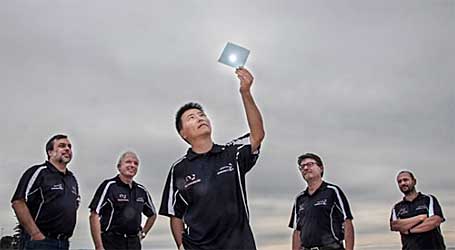
Researchers at the University of Wollongong (UOW) south of Sydney, Australia, are not the first folk to talk about using seawater to create hydrogen. And they are also not the first to develop an artificial leaf to do the same. But, nonetheless, the scientists at UOW (pictured above) think they have built a better mousetrap.
According to UOW, “Using this method, as little as five litres of sea water per day would produce enough hydrogen to power an average-sized home and an electric car for one day.
“The research team at UOW’s Australian Research Council Centre of Excellence for Electromaterials Science (ACES) have developed a light-assisted catalyst that requires less energy input to activate water oxidation, which is the first step in splitting water to produce hydrogen fuel.
“The research team, led by Associate Professor Jun Chen and Professor Gerry Swiegers, have produced an artificial chlorophyll on a conductive plastic film that acts as a catalyst to begin splitting water.”
The researchers artificial leaf, chlorophyll, and flexible polymer (the square pictured above) provide another step toward cheap and abundant hydrogen. And you just gotta love the name, Wollongong, to boot.
Comments are closed here.